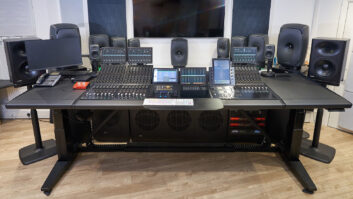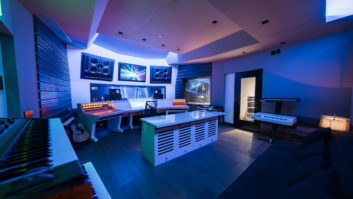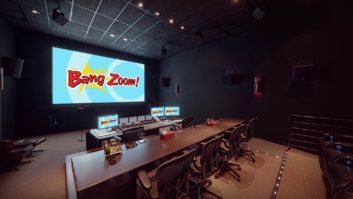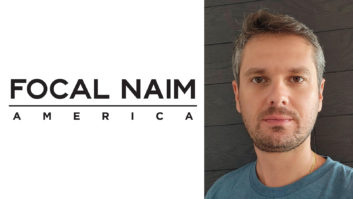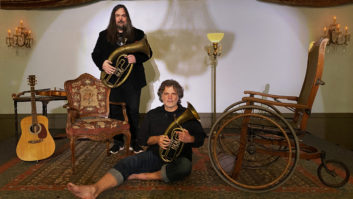Just when sound editors and mixers were getting a handle on drop-frame, nondrop and the idiosyncrasies of international video/film formats, along come HTML coding, bandwidth optimization, JavaScript and cross-browser compatibility. Sound a bit intimidating? Sure. But it doesn’t have to be.
Despite the gloom-and-doom press of the past year, the Internet is very much alive and well, and for anyone working in sound-for-picture, it seems a sure bet that Internet audio is going to be the Next Big Thing. While most applications thus far have focused on streaming and MP3, the notion of music and sound effects loading with the Web page, providing a backdrop similar to television spots, is ready today.
Many companies have developed custom sounds for particular sites, but Sonicopia, a San Francisco-based Web audio developer, has taken the idea one step further, providing a tool for any Web designer to add music, voice and effects in real time. No need to learn coding; the drag-and-drop interface in the newly released (available in November) Pulse Sonifier writes it into the page.
Stuart Dubey, an Emmy- and Clio-winning composer/producer and the owner of audio post house Dubeytunes Studios, launched Sonicopia as an interactive audio division about two years ago. He hired application programmers and a business development team, then began batch processing more than 20,000 bandwidth-optimized effects and music cues, many of them original to Dubeytunes, while others came from available libraries they had deals with.
“People have no idea yet how much impact good sound design and audio implementation can deliver on the Web, because most people haven’t really experienced interactive sound,” Dubey says. “Studies have shown that compelling audio creates a more engaging experience and increases the time that people stay on a particular site. Audio brands that were produced for traditional media can be carried over onto Web-based media, creating consistency among broadcast advertising and Web-based advertising. Audio can provide the bridge between the two.
“The trick is, how do you make interactive audio as transparent and seamless as possible so that it doesn’t affect the page performance?” he asks. “Up until now, because of the technology and bandwidth constraints, visuals have been given priority and creative use of sound was absent from the Web. But the way we code the audio, it allows graphics the priority so that if you’re on a high-speed connection, it plays together. But it senses if you’re on a low-speed connection and allows the page to load first along with short bursts of audio data for user interface sounds before the music comes in.”
In May of this year, Sonicopia was acquired by Pulse Inc., a leading technology innovator for interactive 3-D animation on the Web. In Webworld, it’s the equivalent of Avid buying Digidesign, but with greater synergies. “The goal of the combined companies is to provide the next generation of rich media on the Web — the combination of visuals and audio,” Dubey says. “The other big thrust is personalization, or creating the technology that serves as the layer between the information and its delivery. That means everything from having custom sites with audio updated daily, to having a virtual person read e-mails to you.” (Don’t laugh, it’s coming: At SIGGRAPH, Pulse showed a tool for creating a 3-D image out of any 2-D photo, with full lip sync and next-generation text-to-speech capabilities.)
“We are doing the same thing with audio that Pulse is doing with animation,” Dubey says. “We’re basically building a multilayer, ‘multitrack’ soundtrack that can be triggered by the user’s actions or navigation decisions. It’s similar to games, in that the composition and sound design follow different pathways that all transition and segue into each other. No matter where someone is on a page or what they trigger, it should create a harmonic, very linear experience.”
Personalization is the key to the Pulse Sonifier, and the extent to which a Web designer, or any savvy audio engineer, can customize a site is nearly limitless. And it’s simple. During Mix‘s visit to the Sonicopia facilities, Dubey put together a simple audio presentation for a Tahiti travel site in about five minutes.
Because all the work takes place within the browser, the user simply types in the URL of a site, and the Sonifier instantly makes a copy for sonifying. After that, it is a simple three-step, click-and-drag process:
Find Sounds. An audio library search window pops up over the site, with more than 10,000 effects and 10,000 music cues available by keyword, type or theme (Science and Technology, Places and Travel, etc.). Theme sets include music and “pitched effects” in the same key, so that mouse roll-overs and user-interface sounds, for example, play harmonically with the background music. Effects and music are auditioned and then, with one mouse click, loaded into a Sound Bin for placement on particular objects. The catalog management system was developed in conjunction with mSoft, though Sonicopia makes use of a proprietary database.
Sonify. Here’s where you drag and drop the sounds you’ve collected from the Sound Bin onto any objects or images on the page. In our example, Dubey clicked on “parrot” and dragged it to the parrot image so that every time the mouse rolls over, you get a squawk. Background music and effects can be easily added to play on page load. After you’ve placed all your sounds, you simply click Preview and the site plays. If you like it, then you…
Publish. A final designed site can be FTP’d to your server, e-mailed or downloaded to a hard drive for client preview. It’s really that simple.
The initial release of the Pulse Sonifier is technology-agnostic, Dubey says, supporting a range of file formats, including .SWF and Pulse’s .PWC and .PWS formats. “The audio engine in the Pulse Player is extremely robust,” Dubey says, “and the most recent release is starting to incorporate enhanced audio capabilities. At the same time, we recognize that Flash is everywhere, which is why we are converting our MP3s to .SWF files.”
All audio resides on the back end of the Sonicopia server, so files are secure and simply cached in the user’s browser as he or she visits a sonified site. That’s one attraction for record companies, and it’s no surprise that Sonicopia is currently in discussion with the major labels.
But the possibilities are infinite, whether in retail, e-learning, advertising, corporate Intranets or plain ol’ individual promotional sites. The Pulse Sonifier will be available on an affordable subscription basis of $10 to $20 a month.
For more, visit www.pulse3d.com or www.sonicopia.com.
Tom Kenny is the editor of Mix.
